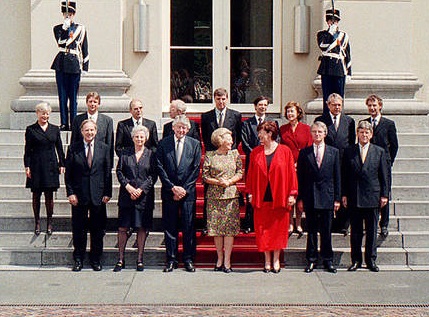Tim
Kingdom of the Netherlands
- Dec 25, 2020
- 1,059
After the resignation of the Heerkens administration earlier in 1998 General Elections were called for the Netherlands. On Wednesday the 23rd of March the ballots were casted, resulting in a new composition of the lower house of Parliament. Three parties that had come under new leadership, the PvdA with Wim Kok, the VVD with Frits Bolkestein and D66 under Els Borst had already shown great interest in working together after the election, seeing how the other major party in the polls CDA did not have plans that were sufficient to help the Netherlands out of the global economic crisis.
On the 1st of april the results were officially verified and the new members of parliament were sworn in. The composition of the Tweede Kamer der Staten-Generaal would be as follows:
The very popular PvdA and VVD had a sizeable majority in the lower house of parliament, but their share in the upper house of parliament was not enough for a majority. Because of this when Klaas de Vries (PvdA) began talks about forming a new government PvdA, VVD and D66 were all invited.
Knowing that the world was in economic crisis changed the formation of a cabinet. Usually they took the time to make a full plan for the next four years, but this time they knew quick action was necessary so they could address the global crisis that was at hand. Because of this they soon realized they had to form a cabinet so they could get to work, and they could later work on more detailed long-term plans together. They took great care in selecting ministers and state secretaries with experience, especially in finance and economics where they installed two experienced ministers. With a cabinet formed they sent it to the queen who had to officially accept it. On the 14th of April the first Kok Cabinet was sworn in. The cabinet was nicknamed the purple cabinet, a mix of the red social democratic PvdA and the blue liberal VVD and D66.

Cabinet Kok after being sworn in with Queen Beatrix
On the 1st of april the results were officially verified and the new members of parliament were sworn in. The composition of the Tweede Kamer der Staten-Generaal would be as follows:
| Total Partij van de Arbeid (PvdA) Volkspartij voor Vrijheid en Democratie (VVD) Christen-Democratisch Appèl (CDA) Democraten 66 (D66) GroenLinks (GL) Socialistische Partij (SP) Sociaal Gereformeerde Partij (SGP) | 150 45 38 29 14 11 10 3 |
The very popular PvdA and VVD had a sizeable majority in the lower house of parliament, but their share in the upper house of parliament was not enough for a majority. Because of this when Klaas de Vries (PvdA) began talks about forming a new government PvdA, VVD and D66 were all invited.
Knowing that the world was in economic crisis changed the formation of a cabinet. Usually they took the time to make a full plan for the next four years, but this time they knew quick action was necessary so they could address the global crisis that was at hand. Because of this they soon realized they had to form a cabinet so they could get to work, and they could later work on more detailed long-term plans together. They took great care in selecting ministers and state secretaries with experience, especially in finance and economics where they installed two experienced ministers. With a cabinet formed they sent it to the queen who had to officially accept it. On the 14th of April the first Kok Cabinet was sworn in. The cabinet was nicknamed the purple cabinet, a mix of the red social democratic PvdA and the blue liberal VVD and D66.

Cabinet Kok after being sworn in with Queen Beatrix



